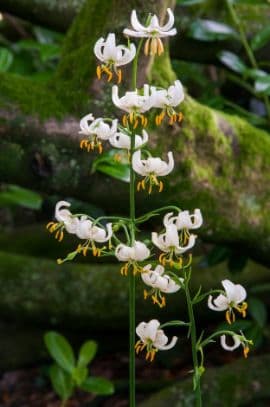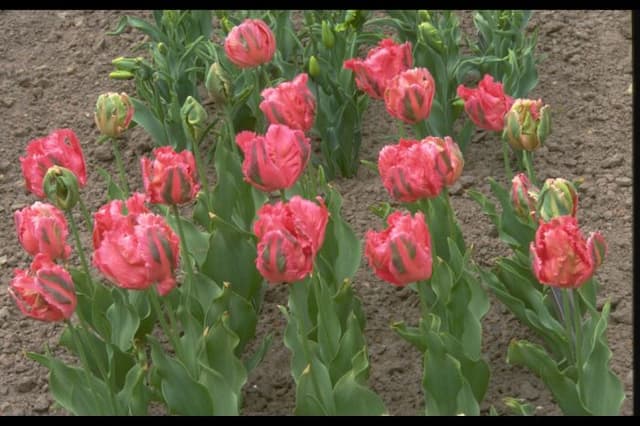Sumatra Lily Lilium 'Sumatra' (Viib/b)

ABOUT
Lilium 'Sumatra', commonly known as the Sumatra lily, is a striking flowering plant with a robust and upright appearance. The Sumatra lily bears large, extravagant blooms which are characterized by their striking coloration. The petals are typically a deep crimson or burgundy hue, often featuring a gradient of color that lightens near the petal's edges or is accentuated with darker spots. The flowers have a curved and slightly recurved form, giving them a distinctive trumpet shape that opens widely to display the interior. The blossoms of the Sumatra lily are arranged in clusters at the top of the stems, forming a sort of loose bouquet. Each flower has six petals and is accompanied by long, protruding stamens that feature anthers coated with copious amounts of pollen. This pollen is vibrant in color, providing a stark contrast to the petals, and it is carried at the tip of slender filament stems which extend from the flower's center. The foliage of this lily is another beautiful aspect, with leaves that are typically glossy and dark green. They are arranged spirally along the stem, with each leaf being narrow, lance-shaped, and having smooth margins. The leaves can be quite numerous, creating a lush and full look that complements the striking flowers above. In summary, the Lilium 'Sumatra', with its large, richly colored flowers and elegant green foliage, is a plant that exudes a sense of grandeur and vibrancy without needing to reference its size to convey its impressive nature.
About this plant
 Names
NamesFamily
Liliaceae
Synonyms
Sumatra Lily
Common names
Lilium 'Sumatra'
 Toxicity
ToxicityTo humans
The plant in question, commonly known as the Lily, is not typically considered highly toxic to humans. However, caution should still be exercised as consuming parts of some lily plants can cause mild gastrointestinal irritation, vomiting, or diarrhea, especially if ingested in large quantities. The most significant risk of lily toxicity is usually not to humans but to pets, particularly cats.
To pets
The Lily is extremely toxic to cats and can cause severe kidney damage. Even small amounts of any part of the plant, including the pollen, leaves, or water from the vase, can be potentially lethal. Symptoms of lily poisoning in cats can include vomiting, lethargy, loss of appetite, kidney failure, and without prompt veterinary treatment, can be fatal. Dogs are less affected, but can still experience mild gastrointestinal upset if they consume lilies. It is crucial to keep lilies out of reach of pets and to seek veterinary care immediately if there is any suspicion of ingestion.
 Characteristics
CharacteristicsLife cycle
Perennials
Foliage type
Deciduous
Color of leaves
Green
Flower color
Red
Height
3 feet (91 cm)
Spread
1 foot (30 cm)
Plant type
Bulb
Hardiness zones
4
Native area
Asia
Benefits
 General Benefits
General Benefits- Decorative Appeal: The striking dark red flowers add a touch of elegance and exotic beauty to gardens and floral arrangements.
- Pollinator Attraction: Attracts beneficial pollinators like bees and butterflies, which are essential for the pollination of many plants.
- Fragrance: The blooms emit a pleasant fragrance that can create a soothing atmosphere in gardens and indoor spaces.
- Easy to Grow: Generally an easy plant to cultivate, requiring minimal maintenance once established in suitable conditions.
- Perennial Growth: As a perennial, it returns each year, providing a long-lasting addition to the garden with proper care.
- Cut Flower Use: The blooms have a long vase life, making them ideal for cut flower arrangements and bouquets.
- Variety of Uses: Suitable for use in borders, beds, containers, and as a focal point in landscaping schemes.
 Medical Properties
Medical PropertiesThis plant is not used for medical purposes.
 Air-purifying Qualities
Air-purifying QualitiesThis plant is not specifically known for air purifying qualities.
 Other Uses
Other Uses- Lily 'Sumatra' petals can be used to create a natural dye for fabrics, giving them a soft, peach to orange tint depending on the concentration.
- The sturdy stems of the Lily 'Sumatra' can be incorporated into floral arts and crafts, such as homemade wreaths or as structure in larger floral installations.
- Dried Lily 'Sumatra' flowers can be used in potpourri mixes, adding fragrance and color to the blend.
- Petals of the Lily 'Sumatra' can be pressed and used in botanical papermaking, adding a delicate, floral touch to handmade papers.
- Lily 'Sumatra' can be used in photography as a prop or subject due to its striking appearance and color for artistic or commercial shoots.
- The plant can serve as an educational tool for botanical studies, demonstrating the features of monocotyledonous plants.
- Lily 'Sumatra' can be used as a natural insecticide; when crushed, some lily plants have been known to repel certain insects.
- Its vibrant flowers can be used to add aesthetic appeal to eco-friendly burial options, such as green burials, where the environmental impact is minimized.
- Blossoms of the Lily 'Sumatra' may be floated in bowls of water to create simple yet elegant centerpieces for events or as part of a spa experience.
- Lily 'Sumatra' can also be a subject in botanical illustration, providing artists with a rich source of color and form for their artworks.
Interesting Facts
 Feng Shui
Feng ShuiThe Lilium 'Sumatra', commonly known as 'Oriental Lily', can be used in Feng Shui to bring in a sense of purity, peace, and abundance. Its vibrant flowers help to enhance the energy within a space and can be particularly beneficial in the Wealth Area to attract prosperity or in the Relationship Area to promote love and harmony.
 Zodiac Sign Compitability
Zodiac Sign CompitabilityThe Oriental Lily is not used in astrology practice.
 Plant Symbolism
Plant Symbolism- Purity: The lilium, commonly known as the lily, traditionally symbolizes purity, especially in religious contexts where it is often associated with the Virgin Mary.
- Royalty: The regal bearing of the lily has made it a symbol of monarchy and royal privilege.
- Renewal and Rebirth: Lilies often bloom in the spring, making them emblems of renewal and the cycle of life.
- Marriage: In some cultures, lilies are given at weddings to represent a lifetime of love and unity.
- Transcendence: The lily's sweet fragrance and striking appearance convey a sense of otherworldliness and spiritual transcendence.
 Water
WaterOriental lily 'Sumatra' should be watered thoroughly whenever the top inch of soil feels dry to the touch. On average, this may be approximately once a week, though it can vary based on environmental conditions such as temperature and humidity. It's important to avoid overwatering as Oriental lilies dislike waterlogged soil. When watering, aim to moisten the soil to a depth of about 6 inches, using about 1 gallon of water per square foot of soil, every 7 to 10 days during the active growing season. During dormancy, in the fall and winter, reduce watering frequency to prevent rot.
 Light
LightOriental lily 'Sumatra' thrives best in full sun to partial shade, with at least six hours of direct sunlight per day. The ideal spot is one where morning sunlight reaches the plant, and then it is protected from the intense sun in the afternoon by light shade. Avoid placing it in heavy shade, as this will decrease blooming and can lead to weak growth.
 Temperature
TemperatureOriental lily 'Sumatra' prefers a temperate climate with daytime temperatures ranging between 60°F to 78°F for optimal growth. The plant can tolerate a brief dip to as low as 40°F, but temperatures below this can damage the plant. On the higher end, ensure it is not exposed to temperatures above 90°F for extended periods, as extreme heat can also be detrimental to its health.
 Pruning
PruningPruning the Oriental lily 'Sumatra' is mainly done to remove dead or dying flowers, which helps to stimulate new growth and can encourage future blooming. Pruning is best performed after the flowers have faded, though some gardeners also choose to remove seed pods to direct the plant's energy into bulb growth. Pruning should be done annually, and spent stalks should be cut back to ground level once all the foliage has died back in late fall.
 Cleaning
CleaningAs needed
 Soil
SoilThe Sumatra Lily requires well-draining soil with a slightly acidic to neutral pH of 5.5 to 6.5. A mix of loamy soil with added organic matter like compost and perlite will ensure proper drainage and aeration. Ensure the soil is fertile and humus-rich to support its growth.
 Repotting
RepottingSumatra Lilies should be repotted every 2 to 3 years, or when the bulbs have outgrown their current space. Larger pots foster good root growth and allow the lily to flourish.
 Humidity & Misting
Humidity & MistingThe Sumatra Lily thrives in moderate humidity, ideally between 40-60%. Preventative measures should be taken to avoid excessive humidity that can lead to fungal diseases.
 Suitable locations
Suitable locationsIndoor
Keep in a bright location with indirect light and good air circulation.
Outdoor
Plant in a sunny spot with well-drained soil and mulch for moisture.
Hardiness zone
4-9 USDA
 Life cycle
Life cycleLilium 'Sumatra', commonly known as the Sumatra lily, begins its life as a bulb that lies dormant in the ground until the conditions are suitable for growth. Once the soil warms and moisture is available, the bulb sends up shoots that develop into sturdy stems with lance-shaped leaves. As the plant matures, buds form along the stem and eventually blossom into the distinctive large, fragrant, deep red flowers characteristic of the Sumatra lily. After pollination, typically by insects attracted to the flowers, the plant produces seed capsules which, when mature, release seeds that can disperse to grow new plants. If conditions are not conducive for seed growth or as a managed propagation method, the bulb can produce offsets (bulblets) that can be separated and planted to produce genetically identical plants. Once the flowering and seed production stages are completed, the aerial parts of the lily die back, and the bulb returns to a dormant state to survive adverse conditions until the next growing season.
 Propogation
PropogationPropogation time
Spring to Summer
The most popular method of propagation for the Lily 'Sumatra' is through division of its bulbs. Ideally, this process should be done in the fall after the foliage has died back, ensuring that the plant has gone dormant for the season. To propagate by division, carefully dig up the bulbs and gently separate them by hand, making sure that each new section has at least one or two scales with a bud. These sections can then be replanted immediately at a depth of about 6 inches (approximately 15 centimeters) and spaced about 12 inches (30 centimeters) apart to ensure adequate room for growth. It's important to water the new plantings thoroughly to help establish them. The divided bulbs will develop roots and shoots over the following growing season, leading to new Lily 'Sumatra' plants.




![Lily [Roselily Chelsea]](/_next/image?url=https%3A%2F%2Fplants-admin.emdemapps.com%2Fimages%2Fplants%2F%2Fimages%2F604b584f6f830.png&w=640&q=75)




